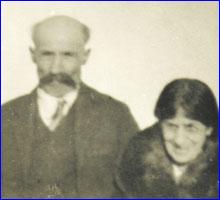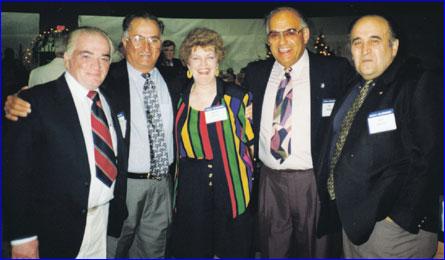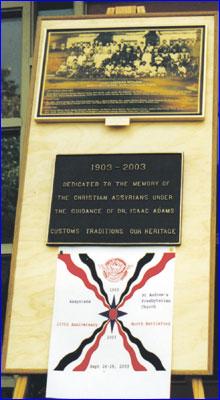


Dr. Isaac Adams, a Presbyterian minister and medical missionary, encouraged Christian Assyrians to immigrate to Canada. Adams, an Assyrian, trained in Scotland. He led the first group of 36 people from Persia (present-day Iran) to North Battleford in 1902.
The Assyrians have a rich history that includes their founding of the oldest Christian church. The Assyrian empire in the Middle East (Mesopotamia and northern Iraq) flourished from 2500 to 612 BC.
Margaret Beach, a member of St. Andrew's in North Battleford, is the granddaughter of one of the original Assyrian settlers and remembers stories from their journey. "When they travelled, they travelled by foot at night because they were fleeing for their lives. They were being persecuted because you couldn't be Christian there." The group had to be careful of bandits and Turkish patrols.
On their journey, they passed famous sites including the Tigris and Euphrates Rivers and Mount Ararat in northeast Turkey, said in Genesis to be the resting place of Noah's Ark. The colony boarded an Assyrian ship in Hamburg, Germany to head to Halifax. They shared space with animals and had little to eat but loaves of bread. From Halifax they travelled by train and oxcart towards the West. They arrived on New Year's Day, 1903. The Canadian government was seeking to populate the West, and for $10 newcomers could own a piece of land after working on it for five years.
Beach's grandfather was one of the settlers who spent their first cold winter in Winnipeg, arriving at North Battleford in the spring to find only tents. Together they built a large house for shelter (later it was converted into the Saskatchewan Hospital North Battleford).
In 1906, Dr. Adams returned to Persia and brought over another 40 settlers -- including Beach's grandmother and mother, then 12 years old.
Each Sunday, the Assyrians met in homes to have a worship service. "They had their own minister speak their own language," Beach explains. Her first language was Assyrian. "As the families grew, the children went to school to learn English and we all started the Presbyterian church in North Battleford."

The majority of Assyrians who came to North Battleford joined the Presbyterian Church. The town paper nicknamed them Presbyassyrians, and published several articles on the settlers.
Outside of their homes, the congregation's first meeting place was in a railroad boxcar. The first local Presbyterian church was Knox, opening in 1906. After building a new church, many Knox members joined the Methodist Church to become part of the United Church of Canada. Members who remained Presbyterian formed St. Andrew's. The location of the congregation changed several times. Finally, in 1961, St. Andrew's had a new church building that became the congregation's permanent location.
The Assyrians have always played a vital role in the church. Beach remembers going right from school to church, where she participated in mission band, choir, Presbyterian Youth and Girl Guides. Later, she was an elder and on the board of managers.

The Assyrians have some customs they continue in North Battleford. They focus more on Jesus' resurrection than birth, making Easter their High Holiday. On Good Friday, women gather and visit the graves of loved ones at the cemetery. Afterwards they have tea and eat a meatless lunch at the home of the woman who has most recently suffered a loss.
Many unique food dishes are part of their Assyrian custom. On Easter and Christmas, special dishes are made like haresa (boiled wheat and chicken breast). Different kinds of cabbage rolls are a popular dish; in Persia they raised sheep, so often the rolls are made with lamb instead of beef.
In 2003, Beach organized a centennial celebration of the Assyrians' arrival in North Battleford. She had help from Rev. Elizabeth Marsh and a committee, and they invited hundreds of people to the September weekend celebration. More than 200 Assyrians came to North Battleford from across Canada and the U.S. The festivities included the dedication of four plaques, a banquet with presentations and the Sunday service held in English and Assyrian.
"It was very nostalgic for a lot of people. People who hadn't been home for years came back," says Beach. The guests included grandchildren of Dr. Adams.
Beach, 76, has four children and eight grandchildren. She has lived in North Battleford all her life. Though no longer serving as an active elder, she remains involved in many aspects of the church. Beach coordinates services at the local nursing home once a month.
Rev. Elizabeth Marsh was St. Andrew's minister from 1995 to 2004. Now retired, she says the 2003 celebration weekend was a highlight for her. "They [the Assyrians] arrived there and there was nothing but swamp in North Battleford," she recalls. "They were instrumental in building the city of North Battleford, as well as the church."
Marsh remembers the many ways Assyrians were involved in the congregation. "The church was the focal point, socially and spiritually, for them." As often as possible, Marsh would include the Assyrian language in the church services.
The early settlers gained their own land, freedom and a lasting relationship with the Presbyterian Church in Canada.
"They went through a lot of hardships," says Beach, "But they persevered, and thank God they did, or we wouldn't be here."

or register to post a comment.